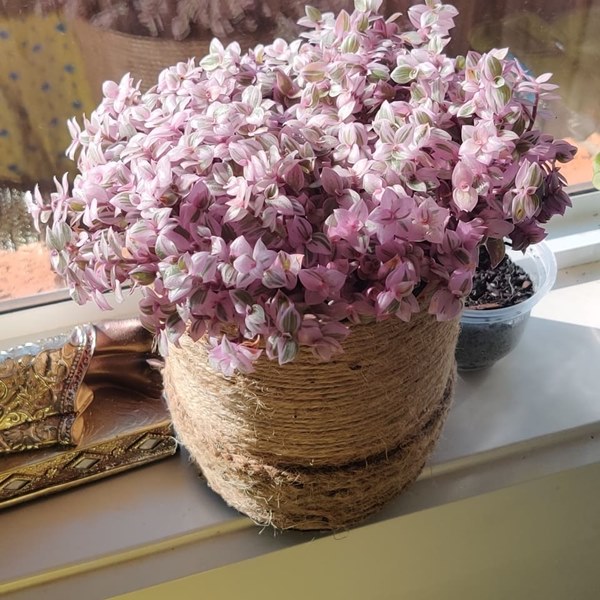Pink Panther Callisia Repens: Care and Growing Guide
Let’s dive in and discover the easy steps to make your Pink Panther thrive and flourish! In this guide, we discuss secrets on how to keep its colors vibrant and its growth happy.

Pink panther is an easy to take care for popular plant with attractive pink and green foliage. This trailing plant is perfect for hanging baskets or as ground cover, adding a touch of pink and green to your indoor space. Make this delightful plant a part of your indoor space, by learning how to take care of the Pink Panther plant.
Botanical Name: Callisia repens ‘Pink Panther’
Common Names: Pink Lady, Pink Turtle, Turtle vine, Callisia Rosato or Tricolor
How to Grow Callisia Repens Pink Panther
Caring for the Callisia repens Pink Panther is relatively easy, making it a great choice for both beginners and experienced plant enthusiasts. Growing the Callisia repens Pink Panther indoors can be a delightful addition to your indoor plant collection. Provide it with bright, indirect light near a window, but shield it from direct sunlight that could scorch its leaves. Maintain a consistent room temperature between 65-80°F (18-27°C) and keep the humidity levels moderate to high. Water when the top inch of soil feels dry, allowing excess water to drain from the pot. Use well-draining soil, and consider fertilizing every 4-6 weeks during the growing season. Prune to maintain its shape and promote bushy growth.
Also Read: Turtle Vine Care
Propagation

Propagating the Pink Panther plant can be an exciting way to expand your plant collection or share this beautiful plant with friends and family. One of the most common methods of propagation for the Pink Panther plant is through stem cuttings. Here’s a step-by-step guide to help you successfully propagate your Pink Panther plant.
- Take cutting from a stem that’s 4-6 inches long just below the leaf node.
- Remove leaves that from the lower end of the cutting leaving a few leaves at the top.
- Allow the cut end of the stem to callus over for a day or two to prevent rot when the cutting is placed in soil.
- Fill small pots or containers with a well-draining potting mix. You can use a mix of peat, perlite, and pine bark.
- Insert the cut end of the stem into the potting mix, and gently press the soil around the cutting.
- Keep the soil consistently moist but not waterlogged. Mist the cuttings with water or lightly water the soil when it begins to dry out.
- Soon the roots will start to form and once the cutting has developed a healthy root system, transplant it into a slightly larger pot
Location
The Pink Panther plant thrives in bright, indirect light. Avoid exposing it to direct sunlight, as this can scorch the delicate foliage. Place it near a window with sheer curtains or in a spot where it receives filtered sunlight throughout the day. A bit of morning sun for a few hours will also benefit this plant immensely.
Soil
Use a well-draining potting mix that retains moisture without becoming soggy. A mix containing peat, perlite, and pine bark works well. Repot your Pink Panther plant every 2-3 years or when you notice it becoming root-bound.
Watering
Allow the top inch or two of the soil to dry out before watering. Stick your finger into the soil to assess its moisture level. When watering, ensure that excess water drains out from the bottom of the pot to prevent root rot. During the growing season (spring and summer), you’ll likely need to water more frequently.
Temperature and Humidity
Maintain a temperature range of 65-80°F (18-27°C) for adequate growth. Avoid exposing the plant to sudden temperature fluctuations and cold drafts. The Callisia repens Pink Panther enjoys moderate to high humidity. If the air in your home is dry, consider using a humidity tray or a room humidifier to create a more suitable environment.
Callisia Repens Pink Panther Care

Pruning
Prune the Callisia repens Pink Panther by trimming leggy stems just above healthy nodes to encourage bushier growth. Remove yellowing or damaged leaves at the base to maintain its appearance and prevent pests or diseases. Regularly pinching back stem tips also helps promote fuller growth.
Fertilization
Feed your Pink Panther plant with a balanced liquid fertilizer every 4-6 weeks during the growing season. Reduce or halt fertilization in the winter months when the plant’s growth becomes somewhat dormant.
Pests and Diseases
Keep an eye out for pests like spider mites and mealybugs. Regularly inspect the leaves and, if necessary, treat the plant with neem oil or insecticidal soap. Apart from root rot caused due to overwatering nothing much seems to trouble this resilient plant.
Toxicity
Pink Panther is considered a safe houseplant around kids and pets including cats and dogs. It does contain some compounds that can cause allergic reactions but only when consumed in large quantities.





